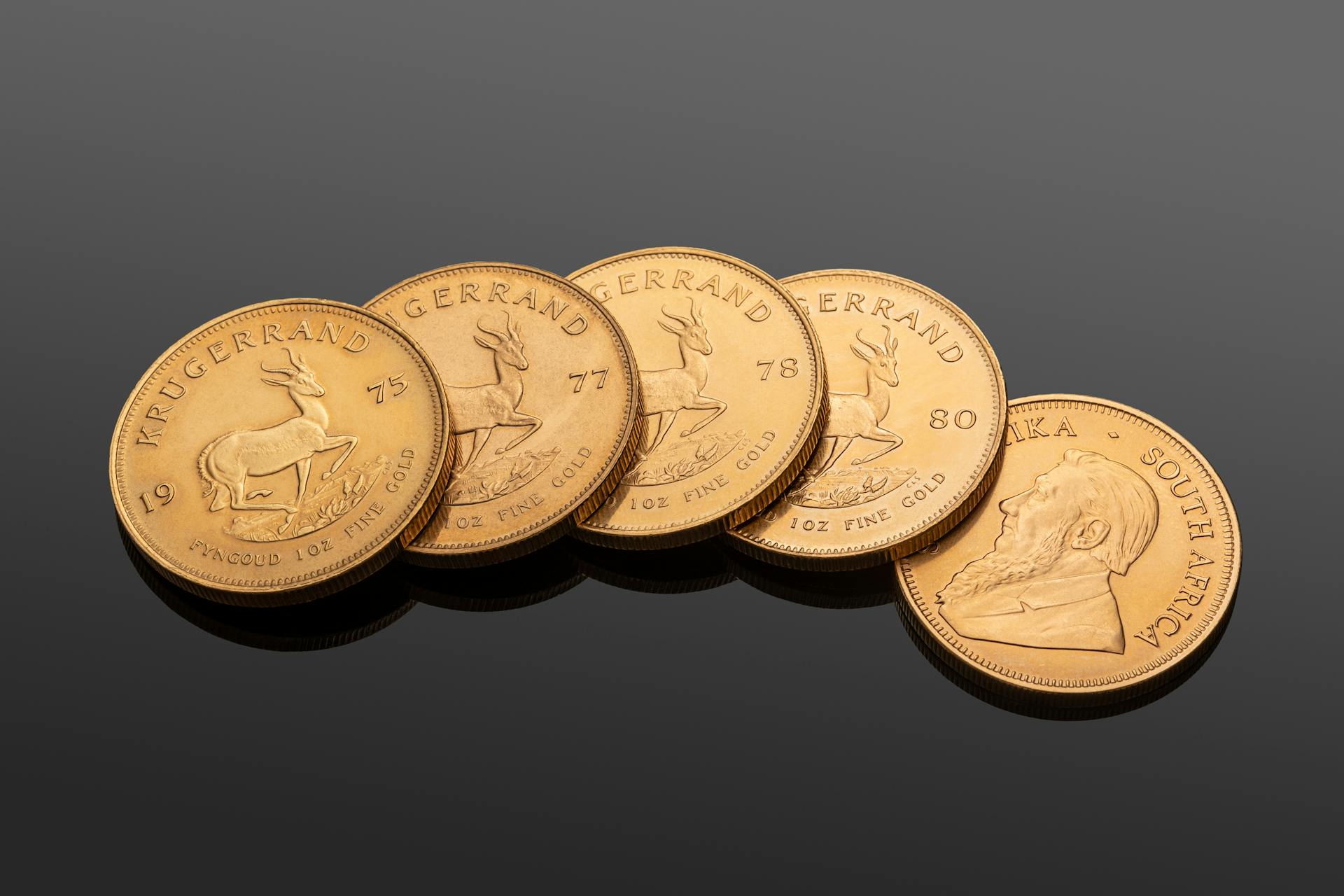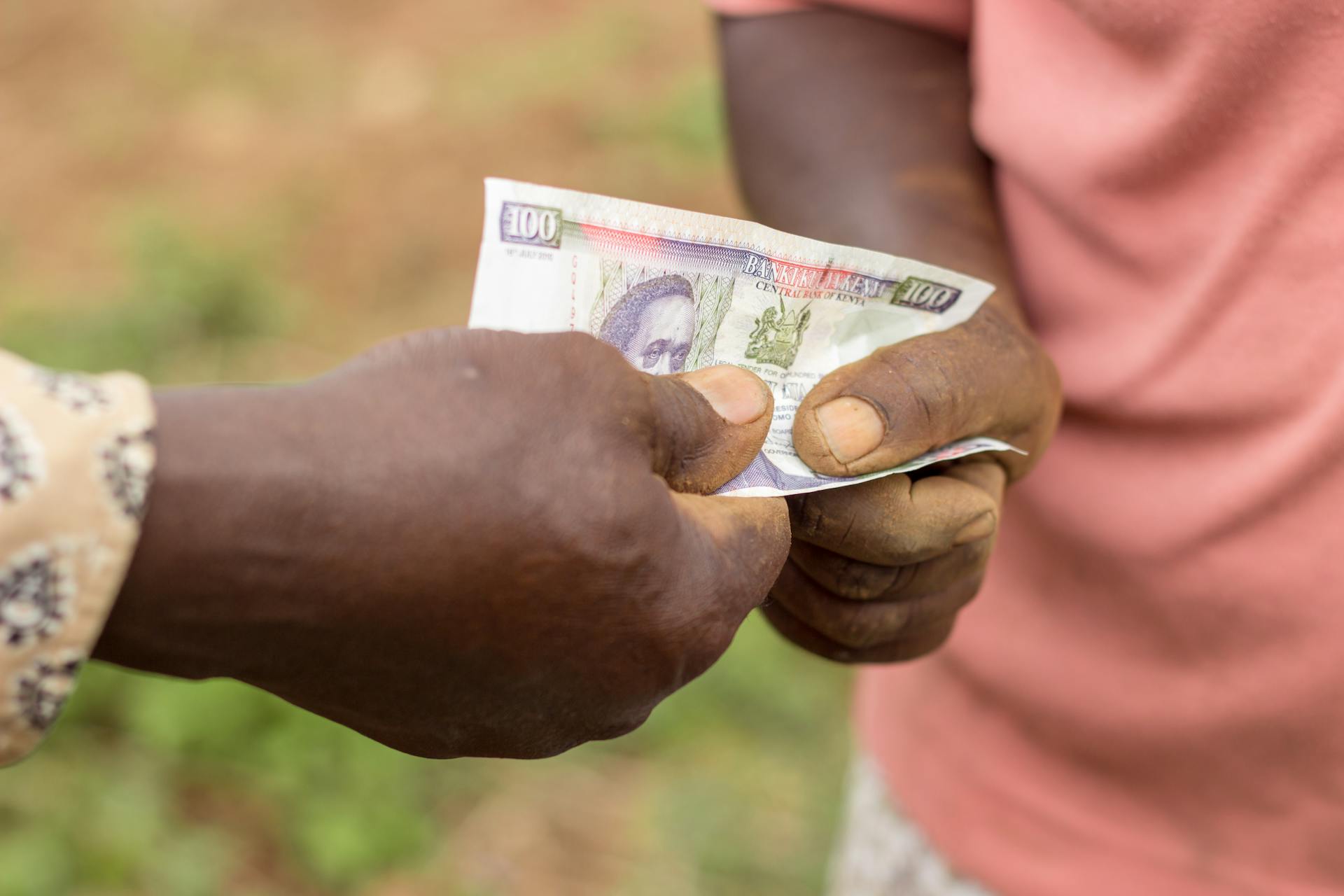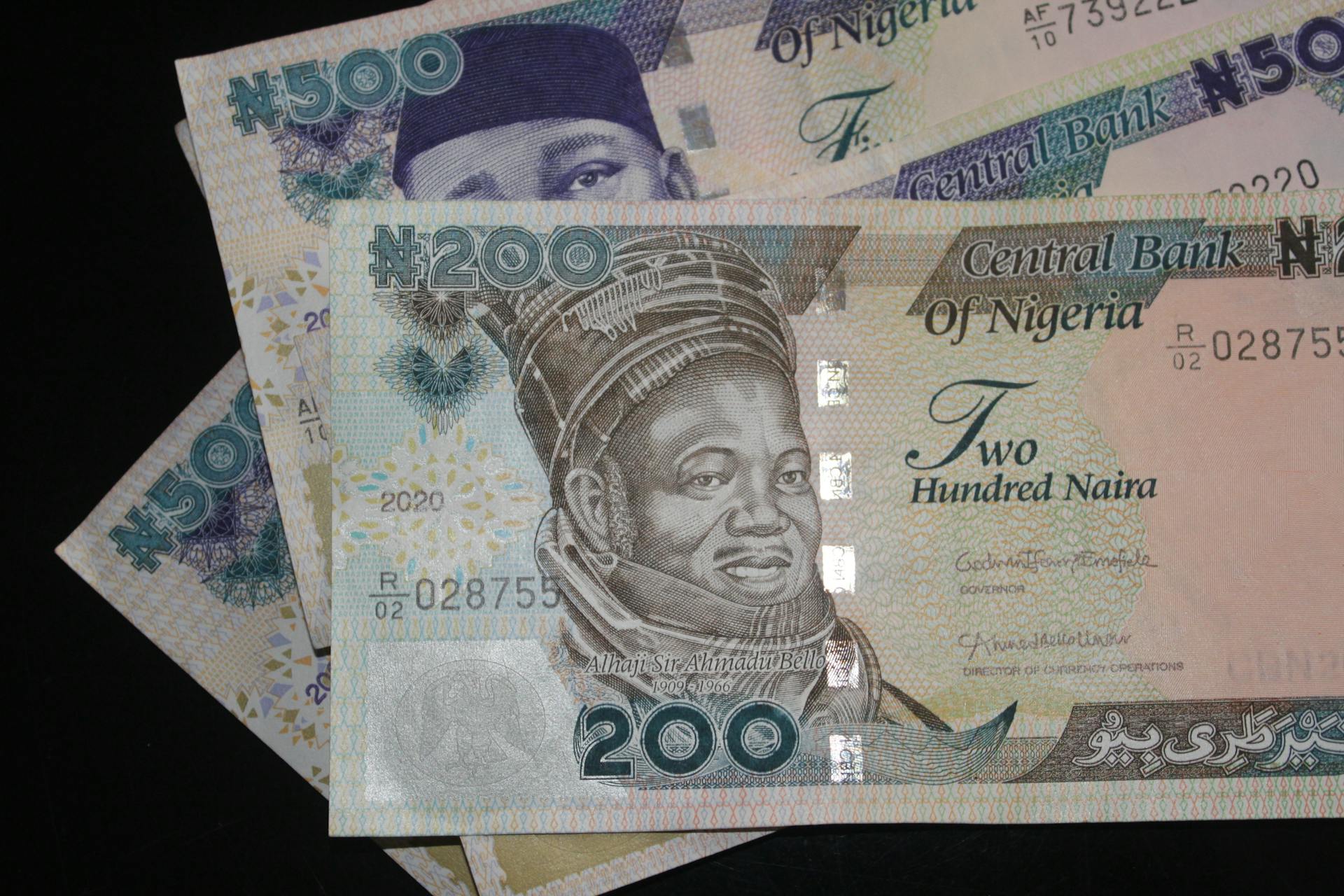
The FCFA, or Franc CFA, is a common currency used by several countries in Africa. It's pegged to the Euro, which means its value is tied to the value of the Euro.
The FCFA was introduced in 1945 as a replacement for the French West African franc. This change was a result of the Bretton Woods agreement, which aimed to reorganize the international monetary system.
The FCFA is managed by the West African Monetary Union (WAMU), which oversees the currency's use and regulation in the region.
Key Concepts
The CFA franc is a widely accepted currency in several African countries. It's backed by the French treasury and pegged to the euro.
The CFA franc is divided into two main types: the Central African CFA franc and the West African CFA franc. Both types are used in different countries.
One euro is equivalent to 655.96 CFA francs, a fixed exchange rate that's been in place for some time. This makes it easy to convert euros to CFA francs and vice versa.
The Central African CFA franc is the official currency of six member nations, while the West African CFA franc is the official currency of eight member nations. Here's a breakdown of the abbreviations used in currency markets:
Use and Criticism
The CFA franc has been criticized for making national monetary policy for developing countries in West Africa all but impossible, since its value is pegged to the euro.
The European Union's 2008 assessment noted that the CFA's link to the euro has had favourable effects in the region in terms of macroeconomic stability, but also acknowledged that benefits from economic integration within the CFA franc zone remain low.
Critics point out that the currency is controlled by the French treasury, and that African countries channel more money to France than they receive in aid and have no sovereignty over their monetary policies.
Exchange Rate
The CFA franc has had a fixed exchange rate with the French franc and euro, but it's undergone significant changes over the years.
The first exchange rate was set at 1.70 French francs for every 1 CFA franc in 1945, but this changed to 2 French francs for every 1 CFA franc in 1948 due to the devaluation of the French franc.
In 1960, the French franc was redenominated, with 100 old francs becoming 1 new franc, and the exchange rate became 0.02 new francs for every 1 CFA franc.
The CFA franc devalued by 50% in 1994, making 1 CFA franc equal to 0.01 new francs.
Here's a summary of the exchange rate changes:
The CFA franc's exchange rate has been closely tied to the French franc and euro, but these changes have had significant impacts on the economies of the countries that use the CFA franc.
Utilisation par la France
The French connection to the CFA franc is an interesting one. The franc CFA is printed in France, which has led some to criticize France for exerting a form of neocolonial control.
The decision to print the franc CFA, however, is made by the BCEAO alone, not by France. This means that France's role is limited to printing the currency, not controlling it.

The French connection goes beyond the CFA franc, though. France also prints the currency for 12 other countries in the CFA zone, as well as for the Comores, Madagascar, Djibouti, Tunisia, Burundi, Namibia, and Zambia.
This practice of printing currency abroad is actually quite common. 17 African countries print their banknotes in the UK, and at least six countries print theirs in Germany.
It's worth noting that the decision to print currency abroad is often driven by cost considerations. Printing currency at home can be expensive, and economies of scale can be achieved by printing elsewhere.
Criticism and Replacement in West Africa
Criticism of the CFA franc has been ongoing, with some arguing that it makes national monetary policy for developing countries impossible due to its pegged value to the euro.
The European Union's 2008 assessment noted that the benefits of economic integration within the CFA franc zone were remarkably low.
Critics also point out that the currency is controlled by the French treasury, leading African countries to channel more money to France than they receive in aid.
African organizations have continued to criticize the CFA franc, with Italian ministers accusing France of impoverishing Africa through the currency in January 2019.
In December 2019, President Alassane Ouattara of the Ivory Coast and President Emmanuel Macron of France announced an initiative to replace the West African CFA Franc with the Eco.
A reform of the West African CFA franc was initiated, and in May 2020, the French National Assembly agreed to end France's engagement in the currency.
The countries using the CFA franc will no longer have to deposit half of their foreign exchange reserves with the French Treasury.
The Economic Community of West African States (ECOWAS) plans to introduce its own common currency, also called the Eco, by 2027.
Regional Use
In many West African countries, FCFA is the primary currency used for everyday transactions. It's widely accepted in Cameroon, the Central African Republic, Chad, the Republic of the Congo, Equatorial Guinea, Gabon, and São Tomé and Príncipe.
In Cameroon, for instance, the FCFA is used in all major cities, including Yaoundé and Douala.
Afrique de l'Ouest (BCEAO)
The BCEAO, or Banque Centrale des États de l'Afrique de l'Ouest, plays a crucial role in the region. It's responsible for deciding how to make the currency, the franc CFA.
The BCEAO's logo, a stylized fishhook, is a nod to the region's rich history and culture. It represents a bronze figurine used by the Akan people to weigh gold.
The BCEAO's decision to make the franc CFA in France has been criticized for allowing France to exert a form of neocolonial control. However, the BCEAO makes the final decision on currency production.
Interestingly, the practice of printing currency abroad is quite common. In fact, 17 African countries have their banknotes printed in the UK, and at least six countries have theirs printed in Germany.
A fresh viewpoint: De Que Pais Es La Libra Esterlina
Évolution au sein de la CEMAC (depuis 2019)
The Évolution au sein de la CEMAC has been a significant development since 2019. The CEMAC's (Communauté Économique et Monétaire de l'Afrique Centrale) membership has grown from 6 to 7 countries, with the addition of the Republic of Congo.
Intriguing read: Que Son Las Tarjetas De Credito Y Para Que Sirven
The CEMAC has also strengthened its economic integration through the creation of a single currency, the Eco, which is expected to be launched in 2024. This move aims to enhance regional trade and economic cooperation.
The CEMAC's economic performance has been impacted by the COVID-19 pandemic, with a decline in GDP growth rates in 2020. The region's economic recovery has been slow, but the CEMAC has implemented various measures to mitigate the effects of the pandemic.
The CEMAC's regional trade has increased, with a growth rate of 10% in 2020. This can be attributed to the region's efforts to simplify customs procedures and reduce trade barriers.
Production and Management
Production and Management is a crucial aspect of the FCFA currency. The Central Bank of West African States, also known as BCEAO, is responsible for managing the FCFA currency.
The BCEAO is headquartered in Dakar, Senegal, and has a mandate to maintain the stability of the currency. It issues FCFA banknotes and coins, which are used in eight West African countries.
The BCEAO also manages the foreign exchange reserves of its member countries, which helps to stabilize the value of the FCFA currency.
Bank Reserve Supervision

Bank Reserve Supervision is a crucial aspect of the Franc Zone's functioning. The Banque de France oversees the reserves to prevent hyperinflation by maintaining a global balance of monetary reserves.
The Franc Zone's pot commun system allows for a balanced distribution of reserves, which reduces the risk of hyperinflation. This system is designed to promote economic stability.
However, countries that are consistently credit-worthy may feel inclined to leave the system. The Gabon and Cameroun are examples of countries that have successfully diversified their economy and strengthened their finances, prompting the French to question the need for their monetary guarantee.
Until 2019, countries in the Franc Zone were required to deposit 50% of their foreign exchange reserves with the French Treasury to ensure liquidity. This reserve was deposited on a interest-bearing account, with the interest paid annually to African countries.
The BEAC and BCEAO held significant deposits with the French Treasury, totaling 3.7 trillion and 5.6 trillion Francs CFA respectively, which is approximately 14.3 billion euros.
Fabrication de la Monnaie Fiduciaire
The fabrication of fiduciary currency is a complex process that raises questions about national sovereignty and economic efficiency. In the case of the franc CFA, it's been criticized for being printed in France, allowing the country to exert a form of neocolonial control.
However, the decision to print currency is made by the BCEAO, a regional economic organization, not the French government. The BCEAO also prints currency for other countries, including the Comores, Madagascar, Djibouti, Tunisia, Burundi, Namibia, and Zambia.
In fact, many countries around the world print their currency in other countries. For example, 17 African countries print their banknotes in the UK, including Angola, Botswana, and Ethiopia.
The practice of outsourcing currency printing is common, with over two-thirds of African countries printing their currency elsewhere, mainly in Europe and North America. This is largely due to the high costs of printing currency domestically.
The Central African Economic and Monetary Community (CEMAC) had considered printing its own currency but ultimately decided against it due to the high costs involved.
Definitions and Usage
The FCFA is a currency used in several West African countries, including Cameroon, the Central African Republic, and Equatorial Guinea.
It's also the official currency of the Central African Economic and Monetary Community (CEMAC).
The FCFA is pegged to the Euro at a fixed rate of 655.957 FCFA per Euro.
Definitions of
The CFA Franc has a rich history, and understanding its origins can be helpful in grasping its current usage. Born in 1945, the CFA Franc was created to avoid devaluing the money in French colonies after the Bretton Woods Agreement.
The initial exchange rate in 1945 was one CFA Franc to 1.70 French Francs. This rate changed to one CFA Franc to two French Francs in 1948, after the devaluation of the French Franc.
The CFA Franc's history is marked by a 50% devaluation in the 1990s, which helped generate GDP growth in the CFA Franc zone between 1995 and 2000.

Here are some key terms associated with the CFA Franc:
The CFA Franc is used as a unit of currency by countries in the West and Central African regions. It has a fixed parity with the Euro, making it a stable store of value in these countries.
Citations Contenant le Mot
In French, citations are often used to add depth and meaning to a text, and they can contain a variety of words, including the word "mot" itself.
The word "mot" is a French term that translates to "word" in English, highlighting the importance of words in shaping meaning and context.
Citations can be used to illustrate a point or to add emphasis to a particular idea, and they often contain words that are relevant to the topic at hand.
In the context of definitions and usage, citations can contain words that are being defined or explained, such as the word "mot" itself.
Frequently Asked Questions
Quelle est la signification du franc CFA ?
Le franc CFA signifie "franc des Colonies Françaises d'Afrique" et a été créé en 1945, après la ratification des accords de Bretton Woods.
Quelle est la valeur de 1 en francs CFA ?
La valeur de 1 Franc CFA est d'environ 1,87 FCFA. Pour obtenir la valeur exacte, veuillez consulter les taux de change actuels.
Featured Images: pexels.com


